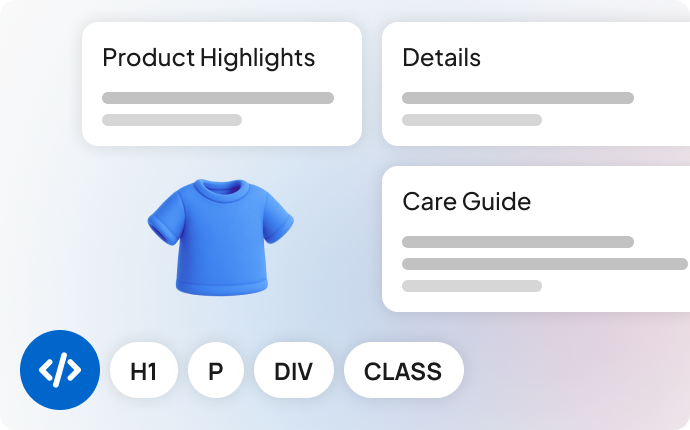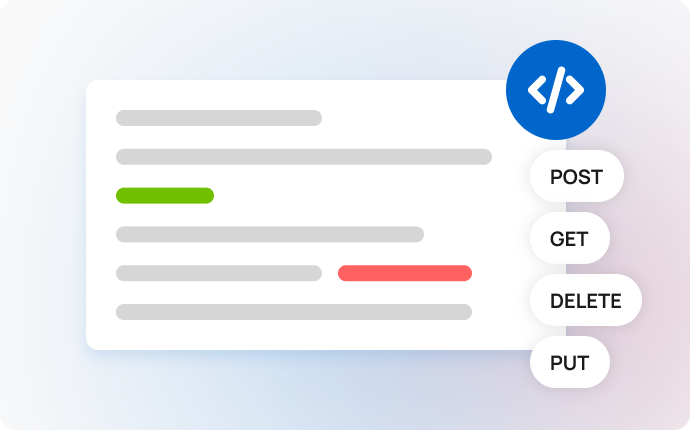Say hello to WriteText.ai 3.5. Full automation, templates, and smarter product research. Discover what's new.
Say hello to WriteText.ai 3.5. Full automation, templates, and smarter product research. Discover what's new.

WriteText.ai gives you multiple ways to style and publish your product and category content—whether you’re working with classic themes, page builders, or custom layouts. Explore the option that best fits your store:
| Plain text transfer. The simplest method: publish AI-generated text directly into your product or category description fields. Quick and easy for stores using standard ecommerce themes. | HTML-formatted text. Generate rich, structured HTML with headings, bullet points, or paragraphs based on templates you’ve set up in WriteText.ai. Perfect for adding hierarchy and polish without manual edits. |
| Page builder mapping. Use block IDs to map WriteText.ai sections (features, FAQs, benefits, etc.) directly into your page builder (Elementor, Divi, Gutenberg, Custom Liquid, etc.). Great for non-dev teams who want pixel-perfect layouts. | Custom layouts with CSS classes. Target individual blocks with CSS class names (e.g., .wtai-features-section). Developers can reposition, style, or transform sections exactly how you want. |
WriteText.ai gives you multiple ways to style and publish your product and category content—whether you’re working with classic themes, page builders, or custom layouts. Explore the option that best fits your store:
Plain text transfer. The simplest method: publish AI-generated text directly into your product or category description fields. Quick and easy for stores using standard ecommerce themes.
HTML-formatted text. Generate rich, structured HTML with headings, bullet points, or paragraphs based on templates you’ve set up in WriteText.ai. Perfect for adding hierarchy and polish without manual edits.
Page builder mapping. Use block IDs to map WriteText.ai sections (features, FAQs, benefits, etc.) directly into your page builder (Elementor, Divi, Gutenberg, Custom Liquid, etc.). Great for non-dev teams who want pixel-perfect layouts.
Custom layouts with CSS classes. Target individual blocks with CSS class names (e.g., .wtai-features-section). Developers can reposition, style, or transform sections exactly how you want.

WriteText.ai enables you to shape your content through flexible prompt inputs, giving you the final say in how your content is crafted, e.g., use the section heading’s special instructions field to define the section name and have AI translate it into multiple languages—ideal for multilingual stores, ask AI to bold specific text and convert measurements (e.g., metric to imperial), or limit the decimal numbers for display, etc.
Explore prompt examples to enhance your content creation, whether you aim for SEO/AEO-optimized descriptions, minimalist messaging, or structured layouts. These examples are perfect for content managers, SEO agencies, marketing teams, and other professionals seeking consistent, on-brand output using WriteText.ai.

Automate product content creation across your store.
Use the WriteText.ai API to generate SEO-optimized product descriptions, category texts, meta data, and image alt text—on demand and at scale for PIMs, ERPs, proprietary ecommerce platforms, and marketplaces like Amazon, eBay, Zalando, Lazada, Shopee, etc.
Automate large-scale content creation with minimal manual effort, and trigger content updates programmatically as your catalog evolves.
Plain text and HTML-formatted transfers require no coding knowledge and work out-of-the-box with WooCommerce, Shopify, and Magento. However, page builder mapping and custom CSS classes may need some developer assistance for precise control over content structure and styling within Elementor, Divi, Gutenberg, or custom themes.
Yes, AI-generated ecommerce content can work with both standard themes and popular page builders like Elementor, Divi, Gutenberg, and custom implementations. Depending on your setup, you can use plain text for simple integrations, structured HTML for formatted content, or map specific sections to page builder blocks. For advanced customization, developers can apply CSS classes to style and position content sections precisely within your existing design framework.
You can guide how AI generates content by using custom to specify instructions for tone, structure, formatting, and localization. For example, you can define custom section headings that translate across multiple languages, specify measurement unit conversions, adjust decimal formatting by region, or bold specific product attributes. This gives you flexibility to maintain brand voice and meet regional requirements while automating content creation across different markets and platforms.
Custom prompts allow you to control content generation for multilingual stores by translating section headings, converting measurement units (e.g., inches to centimeters), adjusting decimal formatting by region, and maintaining consistent brand voice across languages. You can write your custom prompt in any language, but the generated output will always follow the language of your store. This ensures localization consistency across WooCommerce, Shopify, or Magento stores while still giving you flexibility in tone, structure, and formatting.